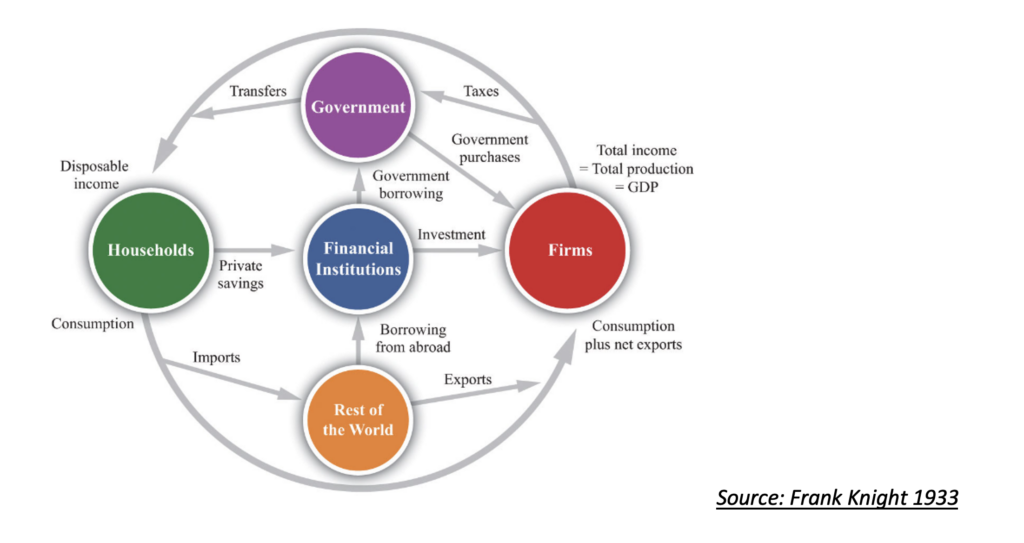Manufacturing recovery in Africa: Africa is famous for resource and mineral wealth – we dig, we sweat, we sell. The world and a few locals get wealthy. But what about the people and the country? Kenya is getting it right.
Manufacturing is in your blood. You understand how economies need it. Then Kenya is the place to be. It’s no longer just about banking/M-PESA, and shareholder returns – it’s about enabling industry, job opportunities, creating value-add, to share basic “wealth” for legions of people. And done through thousands of SME manufacturing companies.
It’s about increasing people’s spending on food, clothes, education, and consumer goods made locally but critically also exported. It’s about the “circular flow of income” below – a self-expanding supply chain of value.

Why Manufacturing
Competitive manufacturing is critical to enable African change and Kenya is leading this. It brings jobs, but critically it adds value to the economy we all share. Globally GDP contribution from Manufacturing is THE way to grow national wealth, not just individual, grow employment but not at the expense of other sectors like agriculture, and grow new revenue from exports to global markets. We have always known this but it’s hard to achieve.
Kenya’s answer to the age of adaptation, The Manufacturing Survey
Previous manufacturing nations’ investments moved away from strong but increasingly low shareholder-return Manufacturing to Services, Financial Sector, and Tourism while they buy from more competitive nations (like China).
- UK post-war 1950s – Manufacturing contributed 46% to the economy (GDP), a boom period of demand and spending, by 2021 it dropped to 15%, now struggling to grow again.
- South Africa 1990, – manufacturing, contributed 25% to GDP, and now it is 9%, a nation that has lost its direction and “gateway to Africa” status.
In Africa, we’ve always relied on agriculture and more recently minerals and resources like gold, oil, copper, and coal. Our “national” mining/resource industries provide a multitude of basic jobs, but as we add little value to these minerals, the economic contribution is poor. We export products and added value. But only a fraction of the wealth from these supply chains is shared with our people.

Kenya Changing History
Kenya steps up. Since the 50s the Kenya Association of Manufacturers (KAM) has motivated and pushed industries and the government to enable growth in the manufacturing sector as they understand what it brings. KAM’s “20by30” initiative to move manufacturing GDP contribution to 20% (from 7.2%) by 2030 is significant for Kenya and Africa.
KAM Chairman Rajan Shah at the annual KAM SME Awards that were held in October in Nairobi, talked about the “Golden Opportunity for Kenya” to grow SMEs to the next level (sustainable growth), where he highlighted:
Manufacturing contribution increase to GDP by 1.6% per year will:
- Move from 338,000 to 1,000,000 additional jobs
- Increase employee compensation (total earnings) from Ksh 232 billion to Ksh 644 Billion
- Release real value-added growth to Kenya’s economy from Ksh 876 billion to Ksh 5.2 trillion
This KAM event was supported by his Excellency the president Dr William Ruto who confirmed to the audience of industry leaders, to move together as a nation, people, policies, and production with the government supporting and on the team.
Enabling Kenya’s Leadership in Africa
President Ruto also mentioned his manufacturing vision that 20by30 means having 8 years to build a whole supportive ecosystem, to move to clean energy to bring down the cost of power, and to move the current 16 million workforce (85% – of Kenya’s 19 million) involved in formal and informal MSMEs to competitiveness. That is global competitiveness as growth has to be led by export, and domestic revenues are inadequate even with expected growth in local consumption spending.
His Excellency highlighted Tea as a leading local export industry. Tea grown in Kenya is competitive because “we don’t just pick it; we process and pack it for the world – value addition”.
Some statistics:
- Africa’s population is 1,200m people with Kenya 4% of this.
- Kenya generates $114 billion in annual GDP, around 4% of Africa’s.
- The average GDP per Capita is $2,175 for Africa with Kenya 3% above this at $2,255.
What does this mean? It means Kenya is currently an average contributor to Africa, with mostly agriculture-based export trade but notably far less dependence on minerals or oil than the leading African export nations. Kenya is in good shape to service this huge manufacturing need to grow jobs and exports.
Kenya is also technically savvy and ready to exploit “Industry 4.0” (the Fourth Industrial Revolution) where the industry rapidly applies technology, increases interconnectivity and smart automation.
This includes implementing an ERP (Enterprise Resource Planning) solution, like SYSPRO ERP, which is specifically designed to enable manufacturers’ supply-chain and financial business processes, focusing on this for 30+ years in Kenya.
Using the massive amounts of data captured from these systems, augmented by external data collected through the Internet of Things (IoT) to feed Artificial Intelligent (AI) which grows “experience” from seeking patterns in the data through Machine Learning (ML). Bringing Predictive Insights before they happen rather than the old BI which told you what had happened that you need to change.
Kenya can leapfrog Africa with “Industry 5.0” – why? According to the European Union Industry 5.0 “provides a vision of an industry that aims beyond efficiency and productivity ….. reinforcing the contribution of industry to society, …. placing the wellbeing of the worker at the centre of the production process while using new technologies”.
Surely this is what Africa needs and Kenya can lead. Enable growing manufacture, employment, exports, shared wealth, and a beginning to the end of Africa’s poverty and ineffectiveness.
Manufacturing recovery in Africa








